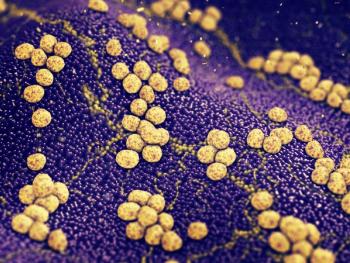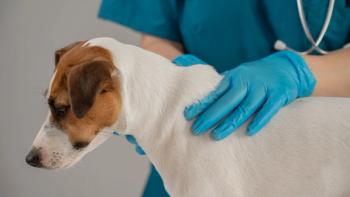
Canine demodicosis: Serious disease requires aggressive therapy
The immune system plays a role in the development of juvenile- and adult-onset demodicosis.
The immune system plays a role in the development of juvenile- and adult-onset demodicosis.
Generalized adult-onset demodicosis, which clinically can appear as squamous or pustular, has been produced using immunosuppressives in adult dogs in which genetic factors are unlikely. A natural decline in non-specific immunity in older dogs can incite the emergence of demodex.
Reports of underlying internal medicine disease, such as Cushing's disease (naturally occurring or iatrogenic), hypothyroidism or neoplasia, can also incite demodicosis. Other studies suggest that development of demodicosis secondary to a concurrent disease is rare. Despite these conflicting reports, studies show that there may be a link between steroid use and emergence of adult-onset demodicosis.
In juvenile-onset demodicosis, a hereditary mite-specific, cell-mediated immunity dysfunction has been proposed. Humoral immunity in juvenile demodicosis appears to be adequate or even more so with antibody titers of affected dogs similar to those of unaffected dogs; a hypercellularity in spleen and lymph-node tissues in affected dogs; and the fact that humoral hyperactivity seems to be present rather than hypoactivity.
Photo 1: Generalized demodicosis in a young Boxer presenting with facial erythema and deep bacterial pyoderma.
However, cellular immunity appears compromised with affected patients having depressed in vitro lymphocyte blastogenesis; lymphopenia and hypocellularity of T-cell areas of the lymph nodes and spleen; and a lower percentage of IL-2 receptors and IL-2 production when compared with control dogs (TH1 cells synthesize IL-2, gamma interferon, and lymphotoxin, and use IL-2 as an autocrine growth factor and drive the immune response toward cell-mediated pathways).
To summarize, generalized juvenile-onset demodicosis is hereditary (probably autosomal recessive) with certain breeds at risk (Collie, Doberman Pinscher, Boxer, Staffordshire Terrier, Scottish Terrier, West Highland White Terrier, English Bulldog, Shar pei and Great Dane), resulting in a specific T-cell defect whereby the mites multiply to large numbers. A secondary bacterial pyoderma develops, which induces formation of a humoral substance causing generalized T-cell suppression. The suppression leads to further increase in the number of mites.
Localized demodicosis is usually limited to the face and occasionally extremities of immature dogs and involves five or less areas. The clinical signs include focal areas of alopecia and erythema on the face, head or legs. The patient should be checked for intestinal parasites, be fed a good-quality diet, and not be administered glucocorticoids. The diagnosis is made by skin scrapings or trichograms, and observing the Demodex canis mite in oil under low-power. Treatment includes benign neglect (90 percent will resolve without therapy) or benzoyl peroxide gel. Goodwinol is a known irritant and can make the patient appear worse. There is some controversy about whether to use topical amitraz on these dogs because some are concerned the localized lesions will become generalized. It is best to treat locally and recheck the patient to closely observe for development of additional areas. Avoid steroid use either systemically or topically.
Along with Demodex canis, two other species of canine demodex mites have been reported — one with a blunted terminal end and the other, an unnamed long-bodied mite. Demodicosis may be more common in the Southeast and Southwest, possibly due to the increased temperature and humidity. The four stages include egg, larvae, nymph and adult. Clinical signs include scaling, comedones and papules, or with the pustular form, crusting and a deep folliculitis/furunculosis. Lymphadenopathy may be present as well as a deep bacterial pyoderma. Otitis externa may be the only presenting sign or a pododermatitis that is often accompanied by pain, swelling and furunculosis. Often a yeast nail-bed infection is diagnosed, but the primary pododermatitis caused by demodex is missed. A cure for juvenile-onset demodicosis is usually more likely than with adult-onset.
Photo 2: Focal area of demodex in the medial canthal skin of a young Labrador Retriever.
Photo 3: Focal area of erythema and alopecia on the muzzle of a German Shepherd with focal demodex.
The diagnosis of demodicosis is made by squeezing the affected skin, then performing deep skin scrapings or hair plucks to observe them in oil under low power.
Occasionally skin biopsies are necessary in cases of mites that reside deep in hair follicles or sebaceous ducts. This most often occurs in the Shar pei and when demodex of the feet are present (either one foot or all four may be affected). Also advisable is a complete blood count, serum profile, urinalysis, fecal exam and heartworm test with possible thyroid panel, ACTH stimulation test and chest/abdominal radiographs if dealing with adult-onset disease.
Treatment options for juvenile- or adult-onset demodicosis include steroid avoidance either systemically or topically, bathing in a follicular flushing shampoo such as benzoyl peroxide, and antibiotic therapy for the concurrent bacterial pyoderma.
Total body clipping may be required in long-haired dogs to facilitate dipping if that method of treatment is elected. One of the acaricide treatments below may be used (do not combine therapies):
- Amitraz dips: The only FDA-approved therapy for generalized demodicosis. Amitraz is an alpha-2 agonist, monoamine oxidase inhibitor (MAOI) and prostaglandin inhibitor. The dip should be diluted according to manufacturer's directions, for example, one bottle/2 gallons water (0.025%). Biweekly applications in one study resulted in a 22 percent cure rate versus a 78 percent cure rate using weekly applications. The dips should be continued until negative skin scrapings followed by two to four dips beyond that. There is minimal increased efficacy with increasing the concentration when compared with adverse side effects. (A French study used a 1.25% concentration weekly and was 100 percent effective in patients refractory to previous amitraz therapy). The dips should be preceded by a follicular flushing shampoo such as benzoyl peroxide without bathing between dips. Side effects include sedation, bradycardia, polyuria, hypothermia, hyperglycemia and hypotension. Avoid amitraz use with concurrent MAOIs such as doxepin or antihypertensives. Pruritus and erythema following a dip is usually the result of the mites dying off. A fecal analysis may contain many dead demodex mites. Reactions to amitraz should be treated supportively. Yohimbine has been used preceding dips in some sensitive individuals. Owners performing the dips should wear gloves and aprons, and dip the pet in a well-ventilated area. The dip should be discarded after use. Owners who are pregnant, diabetic, on antihypertensives, antidepressants or cardiac medications should not perform the dips. In patients with demodex pododermatitis, an amitraz in mineral oil solution consisting of .13%, .5% or 2% has been used topically daily or every three days with the solution being made fresh daily. One formulation that is suggested is lcc amitraz in 29cc mineral oil.
- Milbemycin: Independent studies by Drs. Reedy and Scott (1992) used milbemycin administered daily at 0.5-1mg/kg BID with a 60 percent cure rate. Milbemycin was used from 30 days to 90 days after a negative skin scraping. A low-dose protocol found a 76 percent cure rate but 75 percent relapsed within the first year of treatment. A high-dose protocol found a 96 percent cure rate with 29 percent relapsing within one year. It is currently unknown how long after a negative skin scraping to continue therapy. I use milbemycin 0.5mg/kg BID until 60 days past a negative scraping. The patient must be heartworm negative before starting therapy. Milbemycin is found to be useful in breeds where ivermectin is contraindicated, such as herding breeds, in dogs with pododemodicosis or excessive skin folds that may be difficult to treat with dips, or where amitraz is contraindicated. Caution should still be used in herding breeds and in any breed using milbemycin. I had a geriatric Yorkshire Terrier that developed head tremors on the 0.5mg/kg BID dose. Reversible head tremors also occurred in a Shetland Sheepdog at 1.7mg/kg/day and two dogs (breed unknown) had reversible ataxia at 3.4mg/kg/day.
- Ivermectin: The beneficial effect may be from stimulation of GABA (an inhibitory neurotransmitter) or an immunostimulatory effect seen in mice. The dose range from 200ug/kg to 800ug/kg orally daily has been used after first testing negative for heartworm. The daily dose is administered 30 days to 60 days past a negative scraping. Ivermectin should not be used in Collies, Shetland Sheepdogs, Old English Sheepdogs, Australian Shepherds or herding mixes. Some say "if white feet, do not treat." Use ivermectin with caution and always start at the low end of the dose range (200ug/kg/day). Geriatric dogs regardless of the breed may be more sensitive to the side effects of ivermectin. Side effects include lethargy, wheals, ataxia and mydriasis. Adverse effects may not occur until two days to three days after administration. Many veterinarians believe if it occurs within four hours, the side effects may be more severe. In patients on long-term ivermectin, chronic toxicity may develop with prolonged daily use because of the drug's long half-life.
Doses of ivermectin for various diseases and side effects:
- 5-6ug/kg—heartworm preventive
- 50ug/kg—dirofilaricide
- 200ug/kg—most common dosage for treatment of sarcoptic mange, LD50 of ivermectin-sensitive Collies and Australian Shepherds
- 1,000ug/kg—mydriasis
- 2,000ug/kg—weight loss, tremors, ataxia in 50 percent of dogs
- 80,000ug/kg—LD 50 for general canine population
Photo 4: Demodex pododermatitis in a Lhasa Apso.
Photo 5: Adult Cocker Spaniel with demodex mites of the perioral area and demodex otitis.
Other therapies:
- Taktic: Mix 1cc with 100cc water and use daily half-body applications. Resolution rate overall: 79 percent. Treatment duration: 3.7 months.
- Preventic Collar: 9% amitraz. Not approved or studied for use in generalized demodicosis. Limited use has shown control of chronic demodicosis.
- Vitamin E: Dr. Figueiredo (Brazil) studied 36 cases of juvenile- and adult-onset generalized demodicosis and found all had significantly lower serum Vitamin E levels than normal dogs. Twenty-seven dogs were treated with Vitamin E 200 IU orally five times daily. Within six weeks, 90 percent achieved negative skin scrapings. Griffin (1992) was unable to demonstrate significantly reduced levels of Vitamin E in generalized demodicosis with/without pyoderma. Vitamin E may be a beneficial concurrent therapy because of its immunomodulating properties.
- Immunostimulants: Have not been evaluated for use in generalized demodicosis.
- Lufenuron: Schwassman (1997) showed no improvement when used once daily for five days/month for two to three months at 13mg/kg or 15mg/kg administered times a week for two to three months in dogs with generalized demodicosis.
- Selamectin: Anecdotal reports suggest it is not helpful.
- Doramectin: 600ug/kg once weekly for five weeks to 23 weeks produced a cure in 10 out of 23 patients.
Demodicosis, whether it is juvenile- or adult-onset, is a serious disease that requires aggressive therapy. Treatment of the accompanying bacterial pyoderma is advisable and no steroids should be used. In adult-onset demodicosis, particularly in patients that have not been on steroids, a search for an underlying disease should be undertaken. Choosing which therapy is suitable for the patient and the owner is essential since contraindications for therapy exist not only for the patient, but in the case of amitraz dips, for the owner.
Dr. Jeromin is a pharmacist and veterinary dermatologist in private practice in Cleveland, Ohio. She is a 1989 graduate of The Ohio State University College of Veterinary Medicine and an adjunct professor at Case Western Reserve University's College of Medicine in Cleveland.
Alice Jeromin
References
- Hugnet C, Bruchon-Hugnet C, Royer H, Bourdoiseau G, Efficacy of 1.25% Amitraz solution in the treatment of generalized demodicosis (eight cases) and sarcoptic mange (five cases) in dogs. Veterinary Dermatology, Vol. 12, No. 2, April 2001.
- LeMarie S, Hosgood G, Foil C. A retrospective study of juvenile and adult onset generalized demodicosis in dogs (1986-91). Veterinary Dermatology, Vol. 7, No. 1, March 1996.
- Mueller R. Treatment protocols for demodicosis: an evidence-based review. Veterinary Dermatology, Vol. 15, No. 2, April 2004.
- Holm B. Efficacy of Milbemycin oxime in the treatment of canine generalized demodicosis: a retrospective study of 99 dogs (1995-2000). Veterinary Dermatology, Vol. 14, No. 4, August 2003.
Newsletter
From exam room tips to practice management insights, get trusted veterinary news delivered straight to your inbox—subscribe to dvm360.




